* (restored)
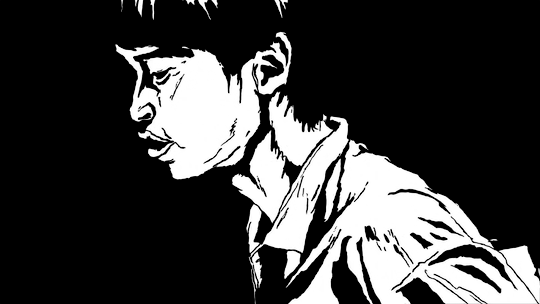
1. GoGo Monster: And here’s Taiyo Matsumoto and the best comic of 2009, a tale of two schoolboys in their third year of classes, one of whom spends most of his time fading in and out of a world of invisible spirits facing an even more obscure threat; it was published in Japan in 2000, right before No. 5 began serialization. I’ve had a review half-written for a little while now — the book came out pretty recently — so in lieu of that I’ll provide a sub-list of Reasons Why This is Great to compliment my Top Ten Funnies and Best of Show Disclaimers rundown:

John rated it really liked it
Taiyo Matsumoto is an amazing illustrator and writer but he seems to do the same story in all the works that I’ve read: two teenage male characters have a coming of age experience with some fantasy or magical realism elements. Typically, one of the characters is exceptional in some regard (an amazing fighter, a great Ping-Pong player, an excellent student) and seems to have some connection to an invisible world, sometimes in the form of a doppleganger. In GoGo Monster, as in Ping-Pong, the magical realism elements appear to be mostly in the mind of the Peko/Yuki character. Whether or not Super Star and the others are real, Yuki, Ganz and IQ all believe that they effect the world outside of Yuki’s head. The art in this book is not quite as polished as in Sunny or Tekkonkinkreet (both of which I believe were published later?), but it’s still engaging. If you’re looking for a typical manga with this book, you’ll probably be disappointed and/or bored as it’s very long, very slow and very strange, despite the fairly mundane setting of a middle school.

“Picture a Batman and Robin story put through a Peter Pan filter by Takeshi Kitano and you’d only be halfway to conceiving the unique, terrible beauty that is Tekkon Kinkreet, previously published under the name Black & White.”
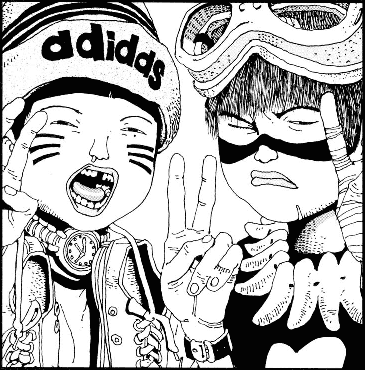
“Matsumoto’s stark, black-and-white imagery won’t be to every reader’s taste; I’d be the first admit that many of the kids in Blue Spring look older and wearier than Keith Richards, with their sunken eyes and rotten teeth. But the studied ugliness of the character designs and urban settings suits the material perfectly, hinting at the anger and emptiness of the characters’ lives. Matsumoto offers no easy answers for his characters’ behavior, nor any false hope that they will escape the lives of violence and despair that seem to be their destiny. Rather, he offers a frank, funny and often disturbing look at the years in which most of us were unformed lumps of clay — or, in Matsumoto’s memorable formulation, a time when most of us were blue: “No matter how passionate you were, no matter how much your blood boiled, I believe youth is a blue time. Blue — that indistinct blue that paints the town before the sun rises.””

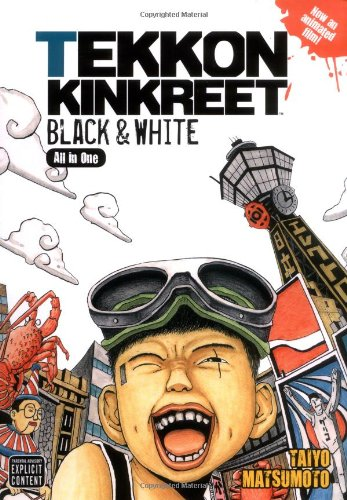
“I felt dizzy after reading this.”
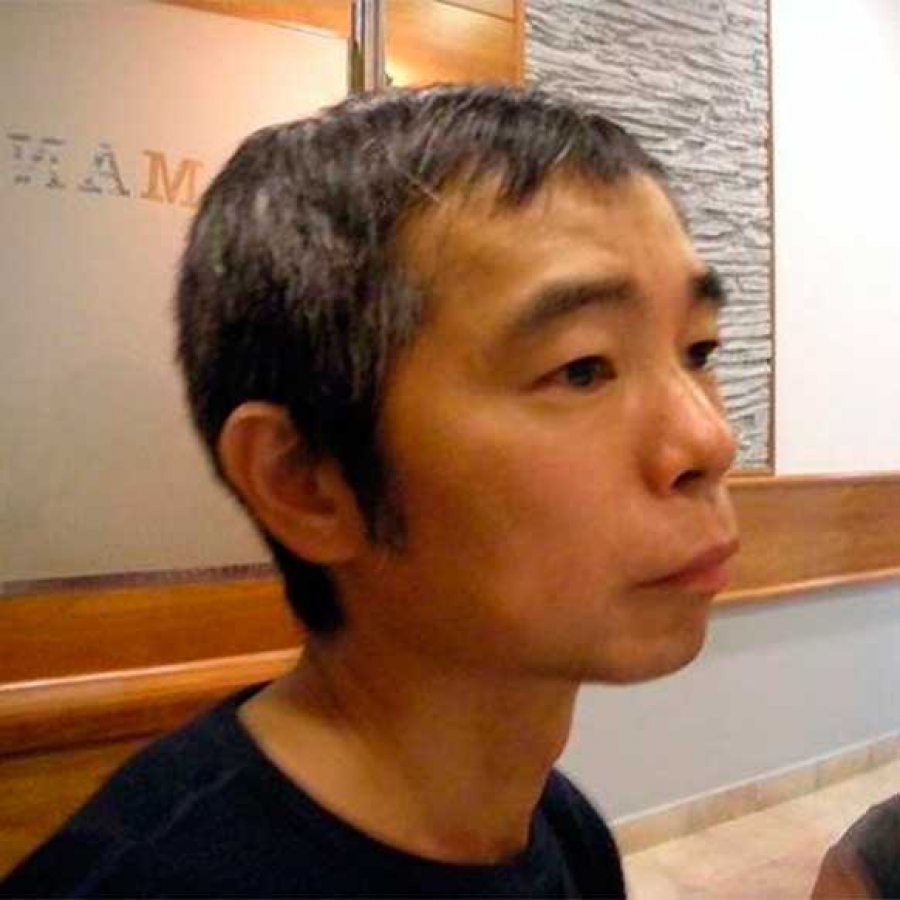
Taiyo Matsumoto is tough for me to write about in any kind of formal fashion. Not sure why. I think maybe some of it may be that he’s such an old influence for me—like I came into his work before Nihei or Daisuke Igarashi—maybe even before Inio Asano-though Asano hasn’t really influenced me artistically—but I think how I got there was I was reading Stray Toasters because when I was first sort of starting to figure out how to draw, I practiced by redrawing Frazetta and BWS, but I was looking at like Sienkiewicz and Ashley Wood—anyways so I was reading Stray Toasters, and my wife of the time saw one of the panels in it, and was like “oh wow, that’s Klimt”—so I went and looked up Klimt and was like “whoa” which led me to Schiele which was a life changing moment. As soon as I saw Schiele I knew there was something in there that I just FELT, and I wanted to explore that feeling through my own work and find my own expression through it.
So in trying to figure out how to take Schiele into comics I ran into Taiyo Matsumoto’s work. I think Tekkinkinkreet was the first work of his I read, then No. 5, then Gogo Monster, then Ping Pong, then Takemitsu Zamurai, and now Sunny. Ping Pong and Takemitsu Zamurai are prolly my fave works by him, with Gogo Monster a close third. But these works were huge to me, and I mean eventually I found Daisuke Igarashi—and I think Daisuke is even closer to my like platonic ideal of comics than even Taiyo is—but Taiyo was key. Maybe THE key. At least after Schiele. So there’s a lot of emotional investment with Taiyo.
I think fundamentally the strength of Taiyo’s work for his whole career is that he doesn’t just tell you here is a boy doing this thing—he gives you something more about the boy at that particular time just in the way his line jitters, or the way the shadow will cloud a face—and maybe the shadow will be these impressionistic brush strokes—or maybe it will be more traditional cross hatching techniques? But the choice always was about communicating something beyond simply what is physically there in the scene.
– Sarah Horrocks

5.0 out of 5 stars A masterpiece.
By Luca Vitale on September 22, 2007
Format: Paperback
This might be the best graphic novel ever written, and I don`t say that lightly. It`s a shame that it doesn`t have a wide circulation in Europe and US. It`s pretty much impossible to compare to anything else, Tekkon Kinkreet it`s the most lyrical and at at the same time the most anti-conformist comic you`ll ever read. Think Miyazaki, Tank Girl and Takeshi Kitano all wrapped up in one story that is so good it hurts. Just get it, if you like indie comics chances are this is your new favorite one.



1.0 out of 5 stars very bad
ByEvzenie Reitmayerovaon January 28, 2010
i dunno about the story.
the pictures are so bad it is hard to follow what is actually going on.
it looks like it was drawn by a 2 years old kid with no talent.
i started to read this book a couple of times but couldnt finish it.
it proves even manga can be drawn very bad.
what a dissapointment.
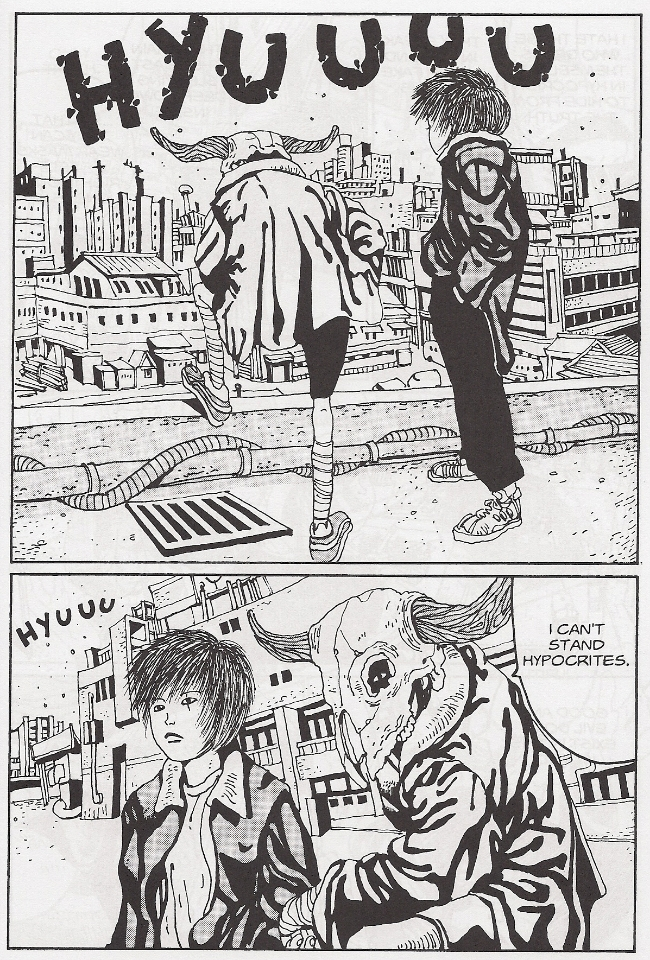
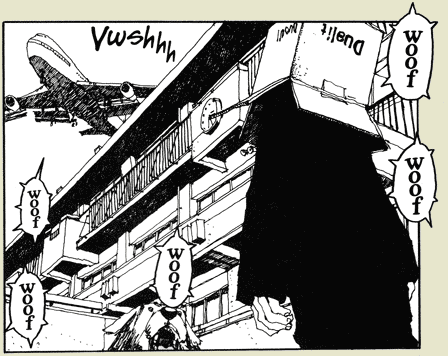
Joey Comeau rated it it was amazing
Shelves: recommendations
This is one of my favourite comic books. It’s surreal and sort of mystical in a way that isn’t lame, but is instead psychological and unexpectedly violent. I was very surprised by this book.
UPDATED REVIEW:
Two years after first reading this book, I have come back to it again and again, each time finding more to love. This has gone from being a really nice surprise and “one of my favourite comic books” to being my favourite BOOK, period.
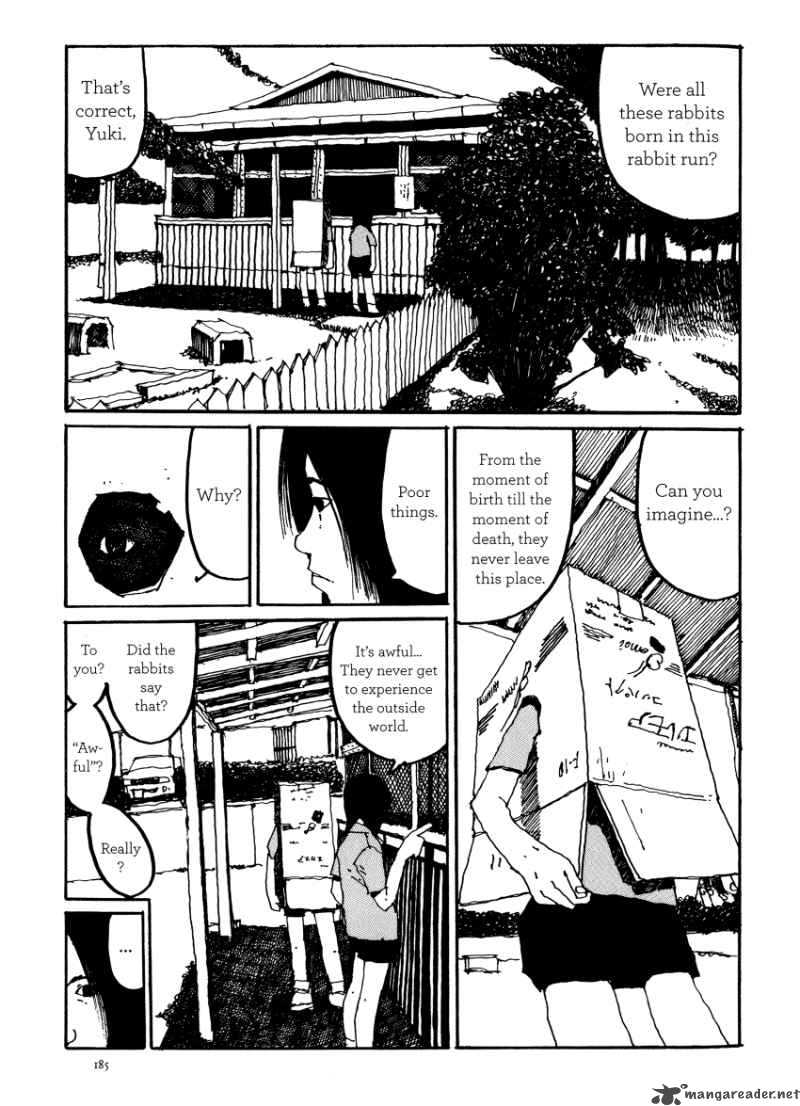
(A) It’s the most furiously cartooned book I’ve read all year, a no-assistants one man show of total vision penmanship that leaves its ‘realistic’ scenery vibrating; buildings literally wave and curve in the background while characters adopt scribbly or sharp appearances based on minute shifts in mood. It’s like Matsumoto seized on the propensity of manga characters in stories where boys see spirits to shift to superdeformed mode when something funny happens and exploded it into three-dimensional sphere of hypersensitive bodily flux.
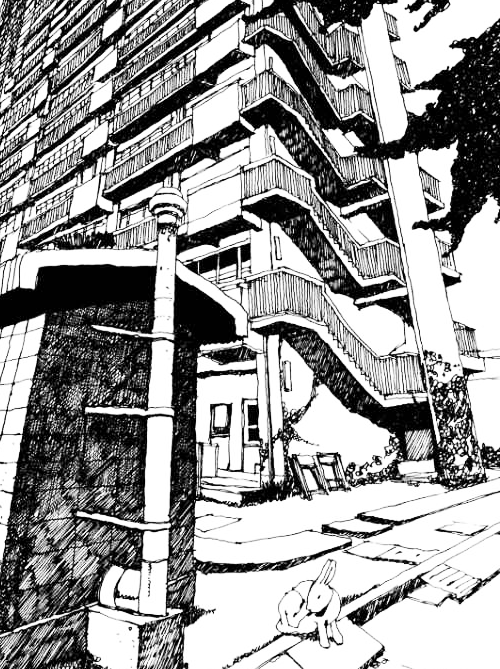
“Although, I’m still not sure why the book is called Gogo Monster.”
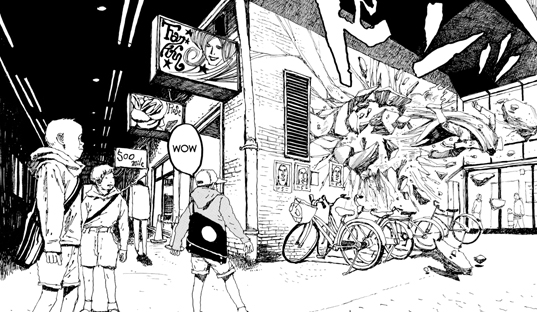
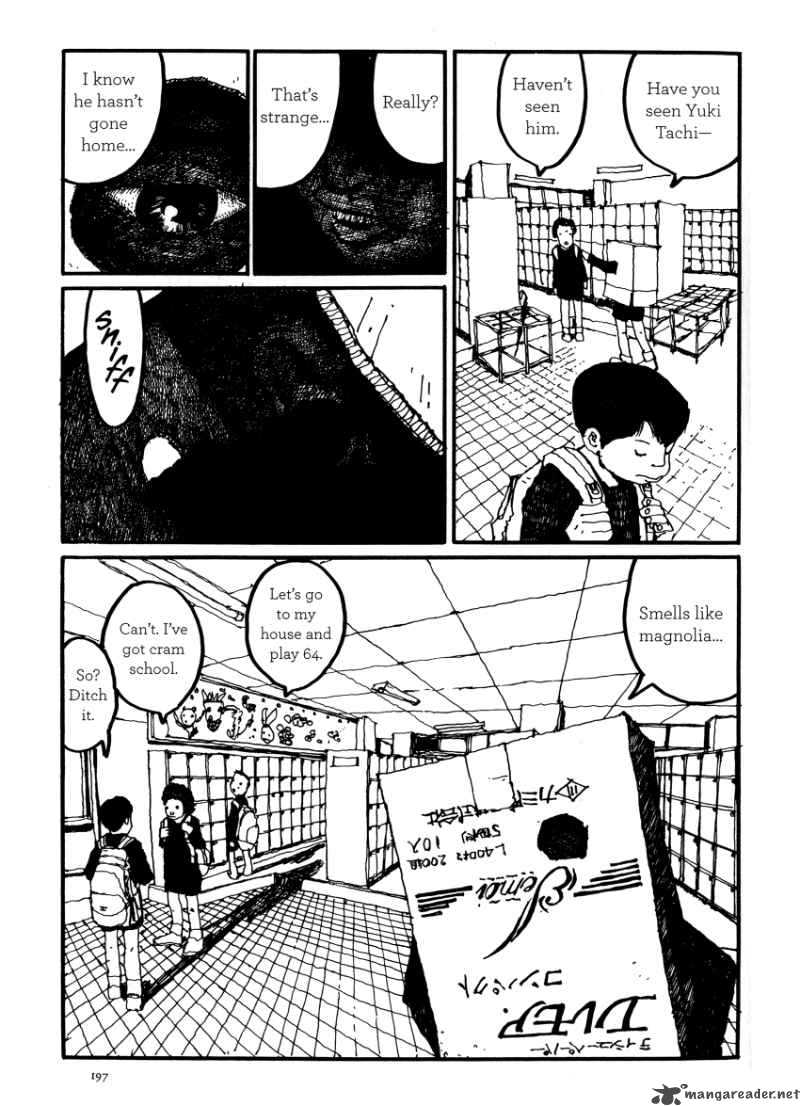

4.0 out of 5 starsFantastic Book
ByChristopher Luceroon January 27, 2013
Format: Paperback|Verified Purchase
All-in-all the book is just an amazing read and a must for everyone. My only problem is that when it came in the mail, the very top part of the slip cover was wrinkled because the shipping. Its kinda annoying but still, the book is something to own rather than just read online.
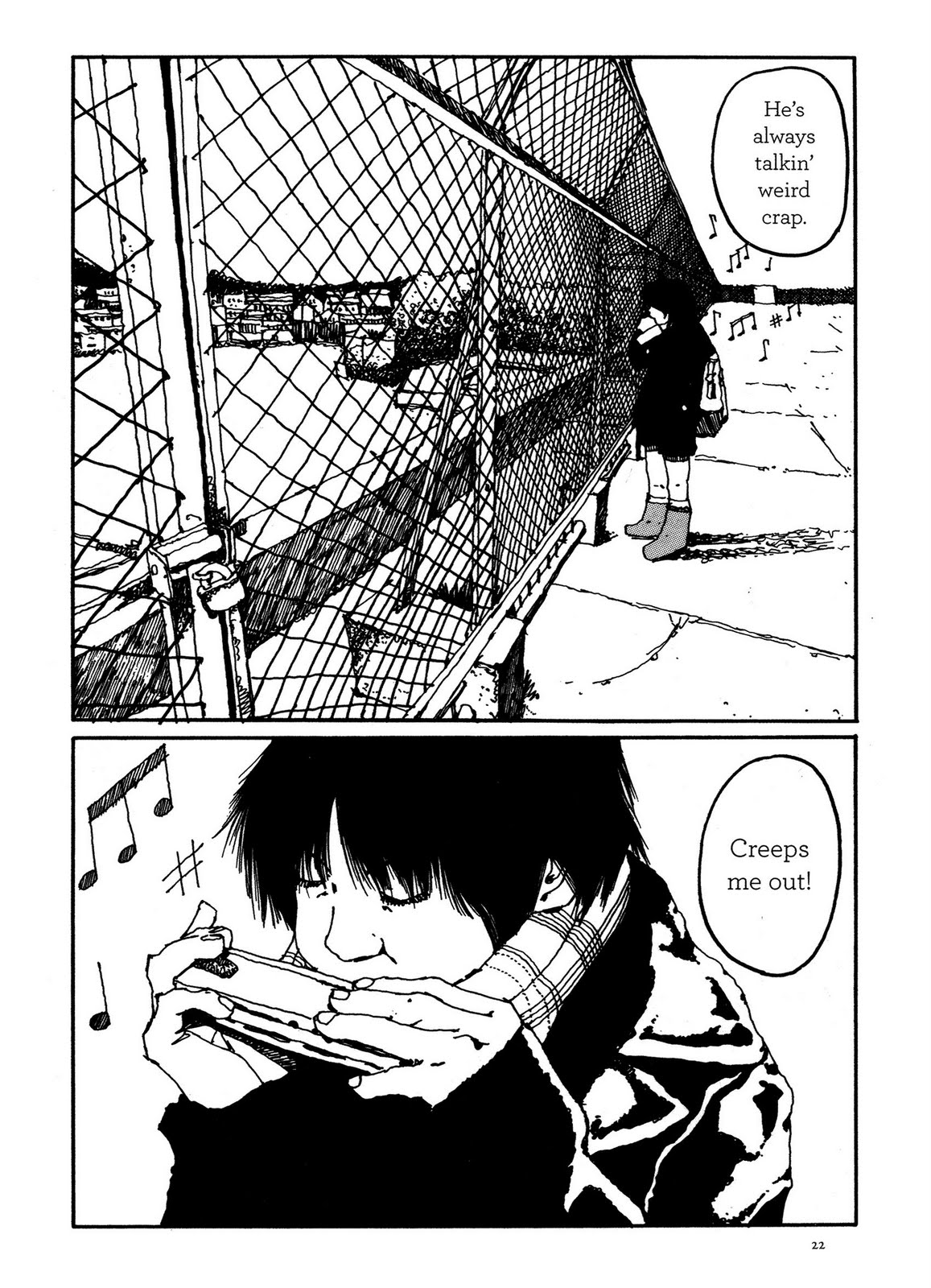
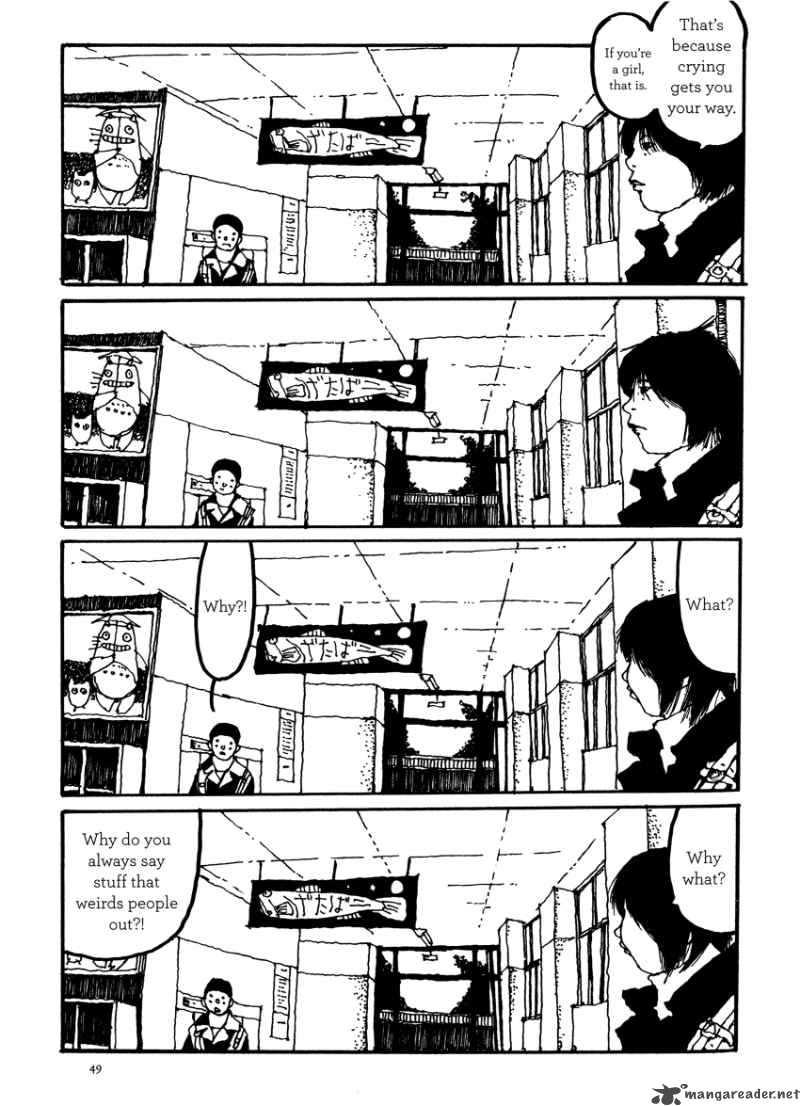

(B) Gone is any trace of the punkish action comics posture of Tekkonkinkreet. Why is that a virtue? Because GoGo Monster functions as a stealthy follow-up project; there’s no doubt in my mind as to why Viz selected it to follow that long-brewing success, since it’s functionally a loose remake, at one point even replicating a plot twist. The trick is, the work formerly known as Black and White concluded with its heroes extricating themselves from the heroic narrative as a means of growing up. Thus, GoGo Monster rips the explicit fantasy out and presents another two boys in a similar story that’s nonetheless entirely different, more delicate, daydreamier. Better.
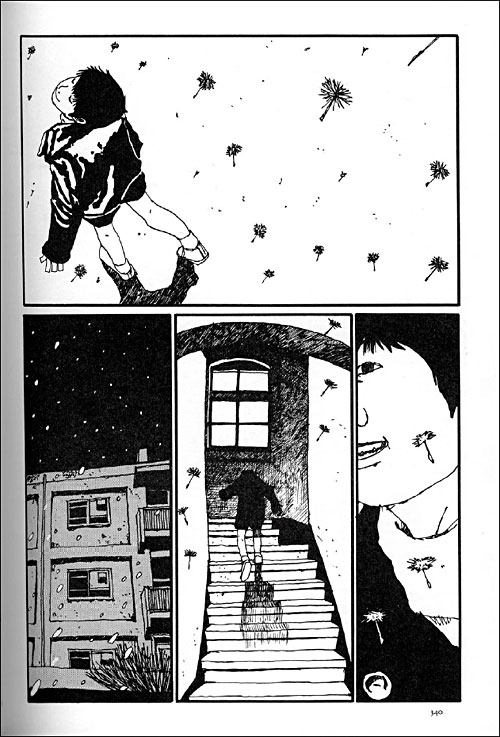
Mabomanji rated it it was amazing · review of another edition
Shelves: bd-comics, friend-s-recommendation
J’adore le style de Taiyo Matsumoto, il dessine avec beaucoup de détails mais surtout avec beaucoup de dynamisme en choisissant des points de vue inhabituels. Il y a une qualité cinématographique à son dessin et à son travail de découpage des planches et d’enchaînement de l’histoire, un vrai travail de montage. Je me suis retrouvée embarquée dans cette folle poursuite à travers le monde entier et j’en ai oublié où j’étais. Le monde futuriste brossé est fascinant et on apprend à chaque chapitre un peu plus sur ce qui s’y passe. Politiquement c’est intéressant avec cette organisation pour le maintien pour la paix qui voit ses jours comptés car elle arrive au bout de sa mission. Reste de le mystère de cette femme libérée par Number 5, elle semble être innocente et pourtant elle a un pouvoir magnétique et semble attirer toute la nature à elle. Un tome passionnant dont j’espère la suite au même niveau.

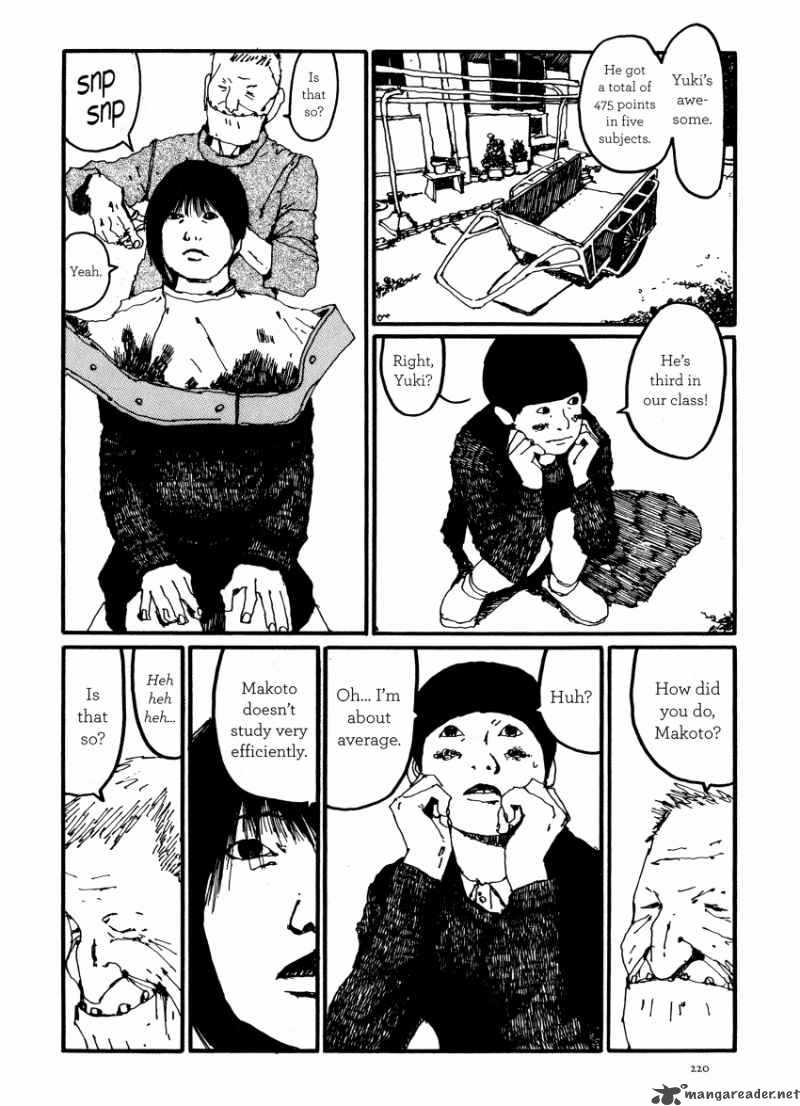

5.0 out of 5 starsDevoted Comics Fans Should Not Pass This One By
ByGraphicNovelReporter.comon December 8, 2009
Format: Hardcover
Yuki Tachibana is an outcast at Asahi Elementary School. He sits alone, drawing on his desk and occasionally shouting out weird exclamations. If he talks to the other children, it is only to warn them about the “others,” beings kept in check only by the power of Super Star, the boss of the other side. Yuki’s only friend is the school’s caretaker, Ganz, though he sometimes talks to IQ, an older student who is academically gifted but interacts with people only through the box he wears over his head. When Makoto Suzuki’s school is shut down for mysterious reasons, he is sent to Asahi Elementary and placed in the desk next to Yuki. Despite the other students’ warnings about Yuki’s strange behavior, Makoto befriends the boy and soon finds himself wondering how much of Yuki’s tales are true.
Matsumoto, manga-ka of Tekkonkinkreet, offers a tale that is part fantasy, part horror, and part mind-trip. On the one hand, it can be read as an exploration into the thought process of a child with autism or a similar disorder, a child who does not see or react to the world the way the rest of humanity does. But on the other hand, Yuki Tachibana might be right and Super Star may be the only thing keeping the beings of the other side from riling the children of Asahi Elementary School to rebel against their teachers, do poorly in class, and be mean to one another. However, it may be that GoGo Monster is neither of those things, or both at the same time.
Matsumoto doesn’t offer an easy read. His plot twists and turns. The dialogue is spare and often consists just of overheard comments that are not necessarily relevant. The characters are mostly inscrutable. And frankly, that is much of the fun of reading GoGo Monster. It is a story to dive into, allowing it to wash over you, and then, later, after it has swirled around in your brain for a time, to dive into again.
The art is as off-kilter as the plot, keeping you searching the panels for hidden details and meanings that may or may not be there, not allowing you to turn the page immediately. Matsumoto’s style is rough, purposefully sloppy. Some characters are realistically portrayed, while others have a messy, cartoonish quality. The drawings within the panels do not always correspond with the dialogue going on at the same time, forcing readers to look deeper for the connection and the meaning. As Yuki is drawn further into the world he sees, the images are terrifyingly subtle. The monsters are never obvious, which heightens the sense of a young boy caught by unimaginable and unseen forces. There is also a lot of beauty in the United States edition of GoGo Monster because of VIZ’s high-quality printing job. The book is hardcover, with the story starting right on the endpages of the front cover. Bright, colorful monsters cover the outside of the book, even overlapping onto the edges of the pages, which are tipped in red and burgundy. A slipcase completes the package.
Readers looking for an artistic read, one that requires that the brain be fully engaged, will find much to appreciate here, as long as they don’t mind taking their time. Other than the typical comments on poop and sex that fourth-grade boys make, there is little to keep this out of the hands of readers old enough to appreciate the strange story. It’s not for every reader, but devoted comics fans should not pass this one by.
— Snow Wildsmith

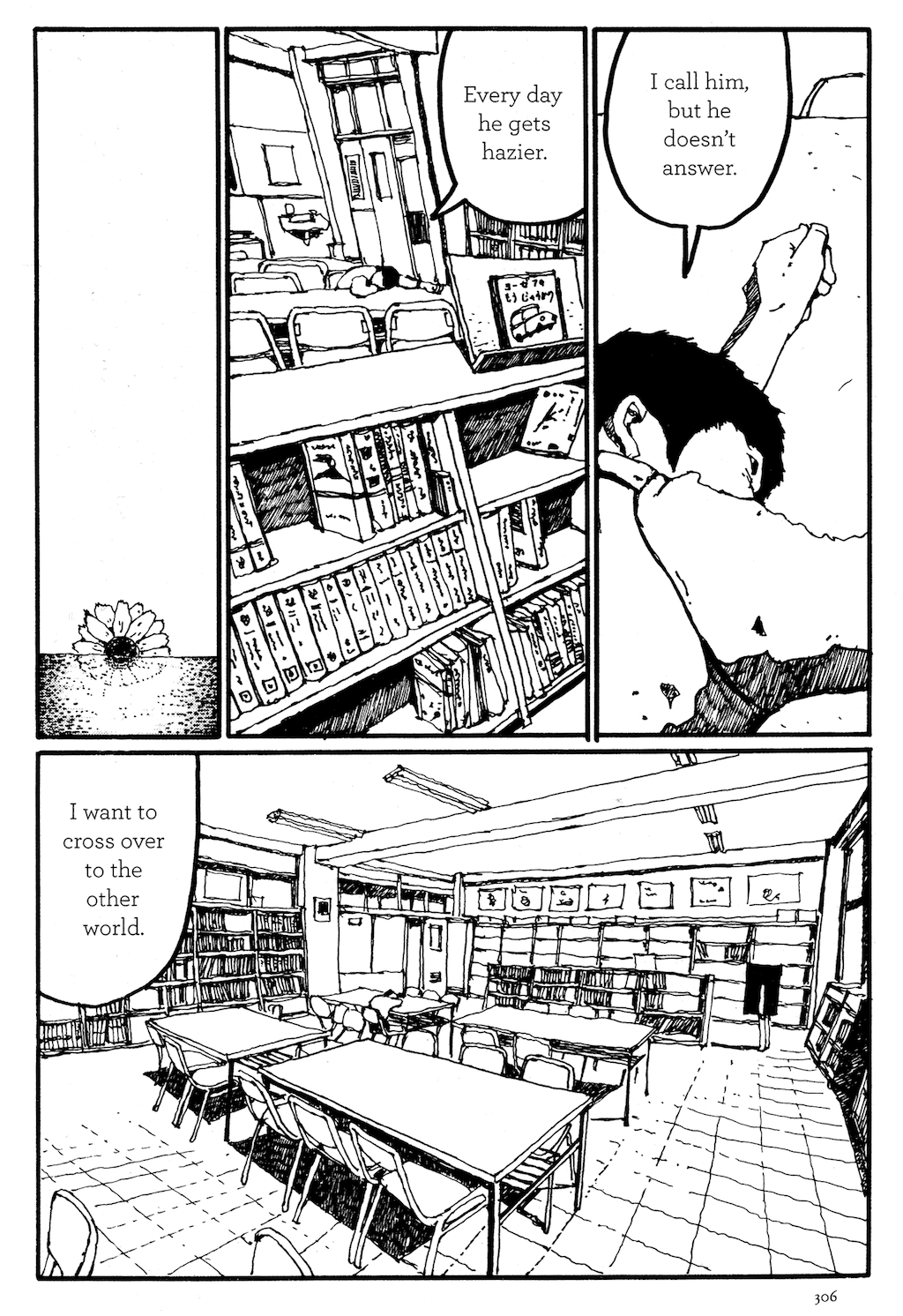
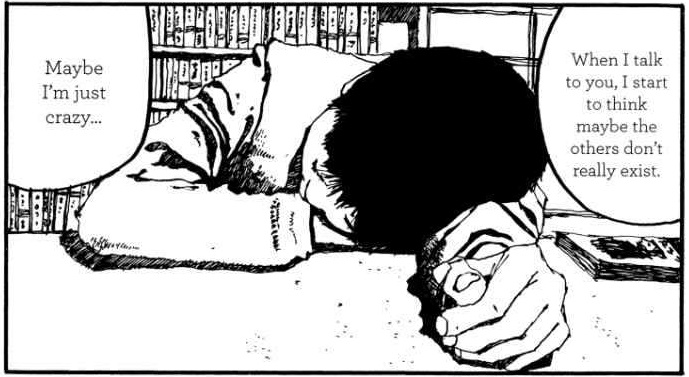
“Did you know that Matsumoto made this manga entirely on his own (no assistants) and did it in one shot. So it never ran in a magazine, he just sat down for a long while and cranked out 448 pages of genius. Seriously who does that?!”

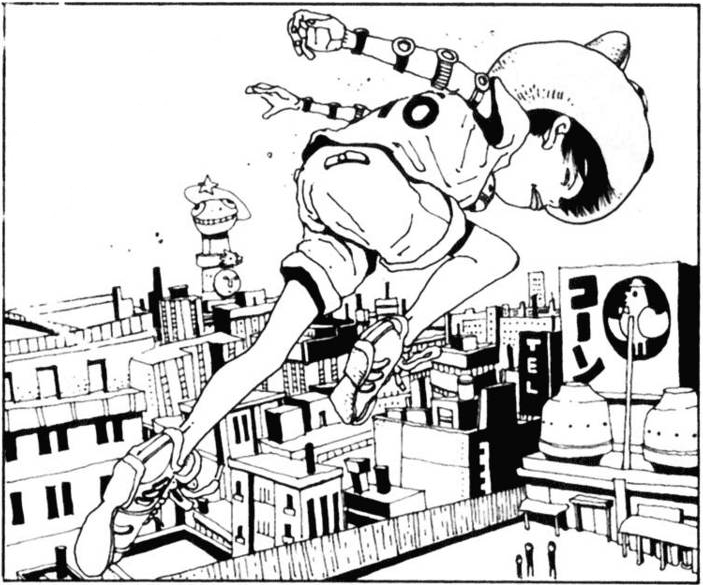
“Tekkonkinkreet melted my mind.”
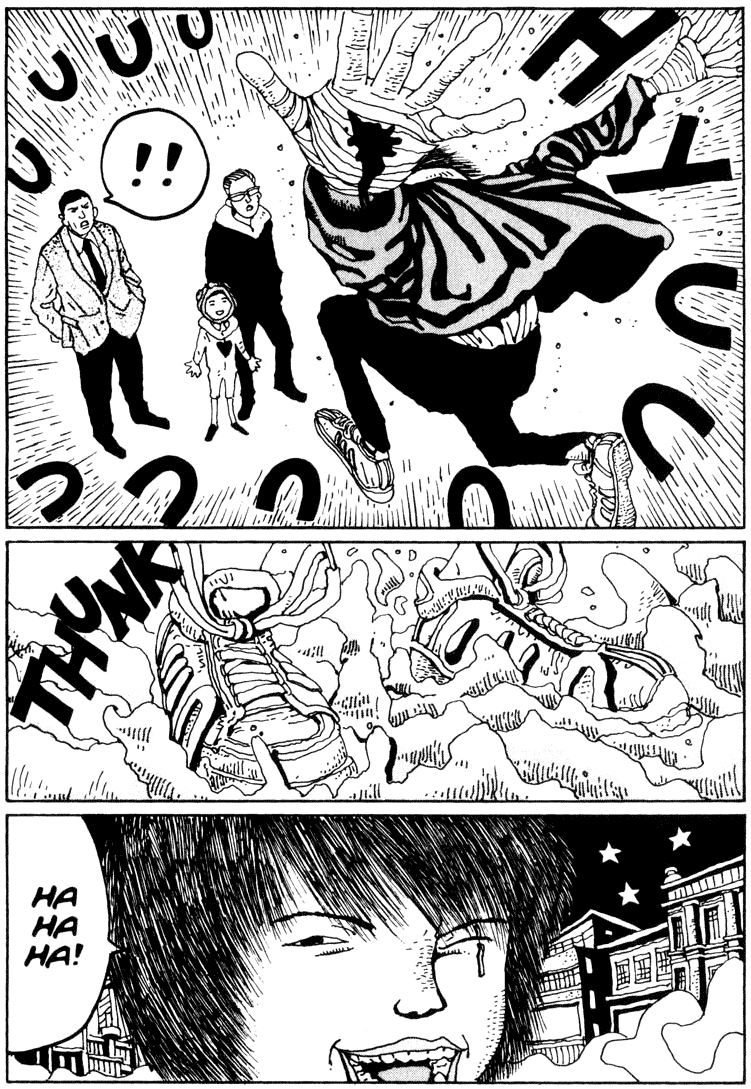
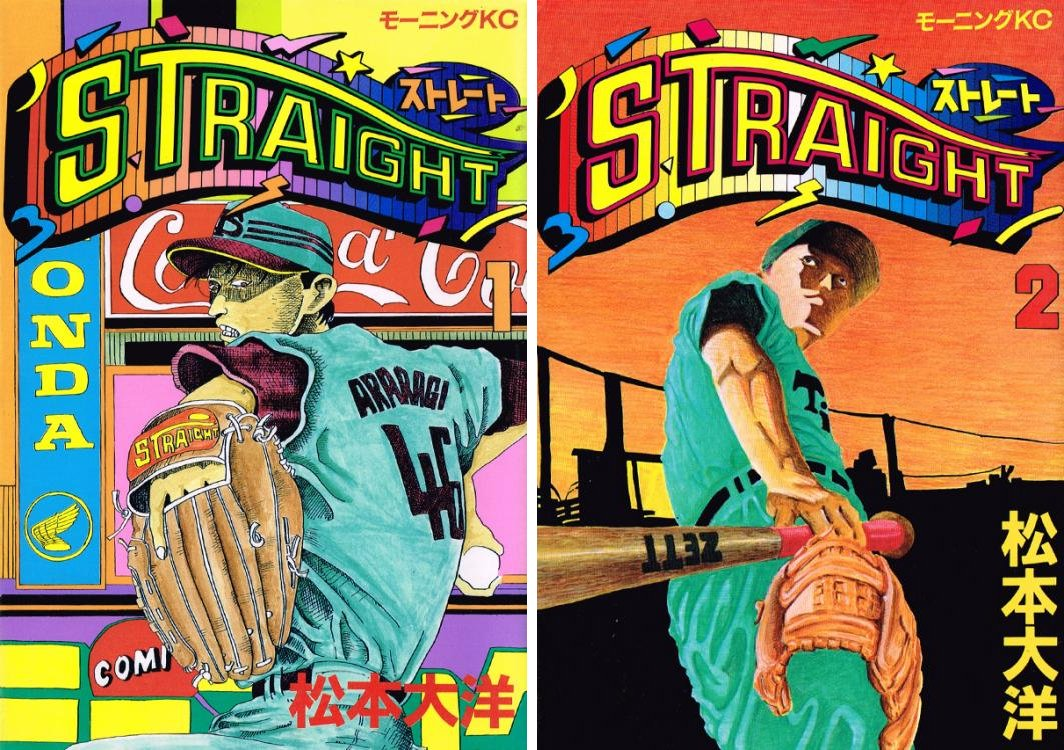
Charlie rated it did not like it
Shelves: graphic-novels, young-adult, japanese
I read this because it was by the same person who made Sunny, and because I couldn’t find Sunny: Volume 2 online. This one wasn’t very good. Mostly it’s just left me feeling gross. I don’t even really know why.
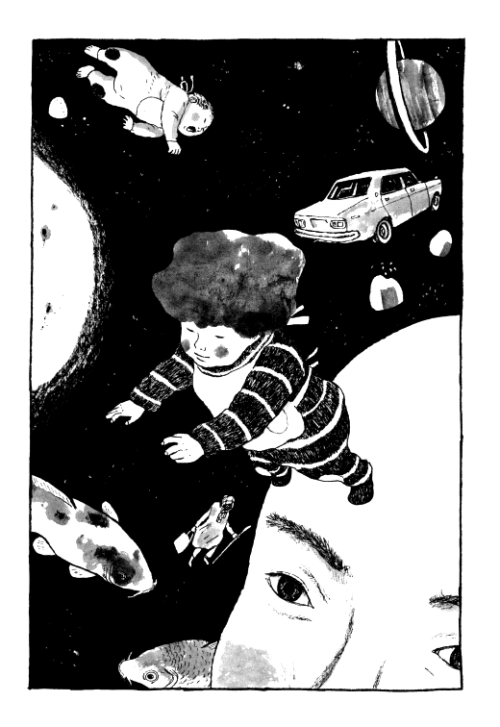

“Creating manga is kind of like you’re a child who’s stolen some money, and when asked about it you lie and say you found it on the ground, but then the grown-ups keep asking more and more questions, and you have to keep making up more and more lies and make it more real. Like, I’ve already gone and said that I’d make this series, so now I have to follow through on that original lie to the end and make it look like something real. People who are good at making manga are really good liars, I think.”
Taiyo Matsumoto, in a 1997 interview.

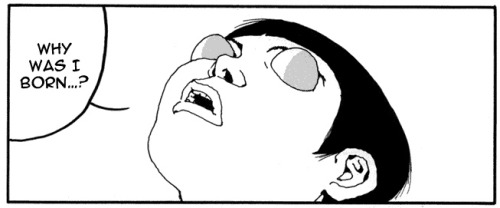
“When people turn into grown-ups, their insides melt into a mushy glop and their brains get hard and stiff,” he tells Makoto. “They get infested with maggots and a purple stink.”
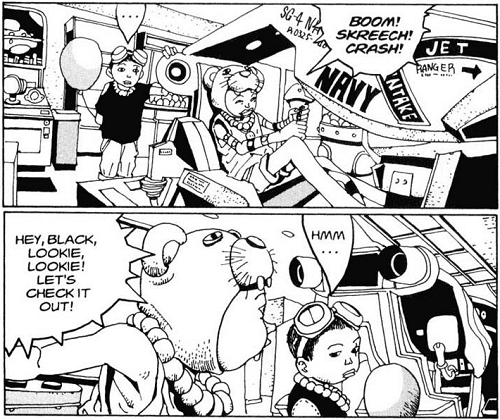
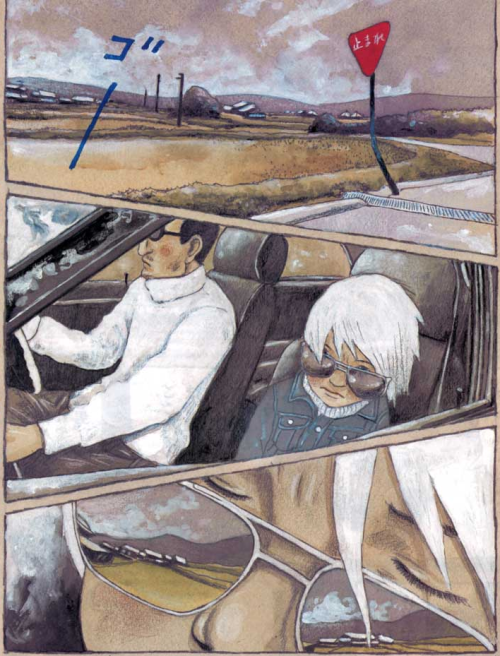
(C) But you don’t need to know that part. GoGo Monster is also a lovely self-contained unit, an original hardcover graphic novel, even in Japan, where such things are pretty rare. Every bit of the format is exploited, with a cardboard slipcase giving way to a wraparound cover that doubles as the work’s first page, although the ‘first’ page is actually page “-8,” which leads into page -7 on the inside-front cover, then -6 through -1 on tinted pages, followed by several pages of black to indicate a narrative break of two years, and then full-color titles on page 0, thereafter counting to over 450 in crisp b&w.; You bet your ass the solid black inside-back cover is significant – it’s another break in time, one we can’t see past.
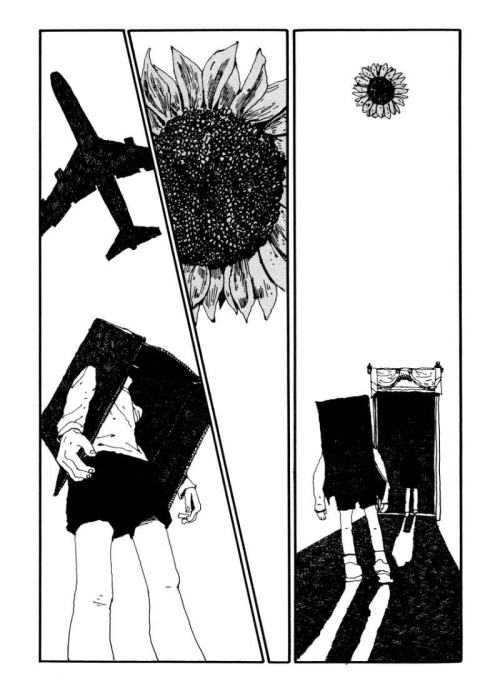
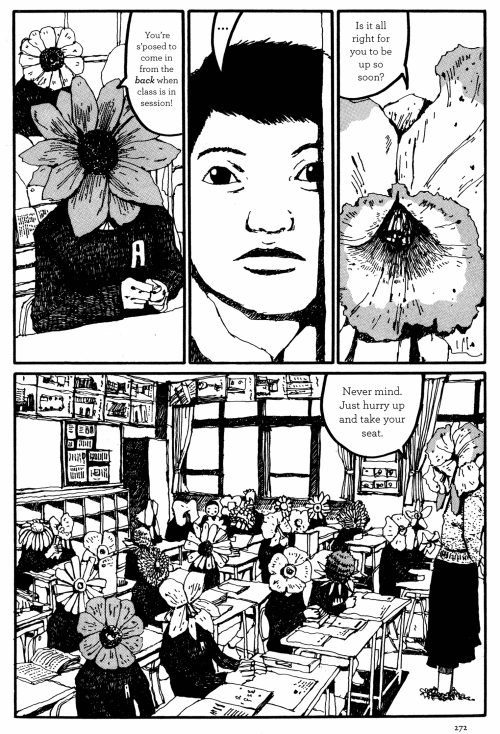
“Unnormal gut.”
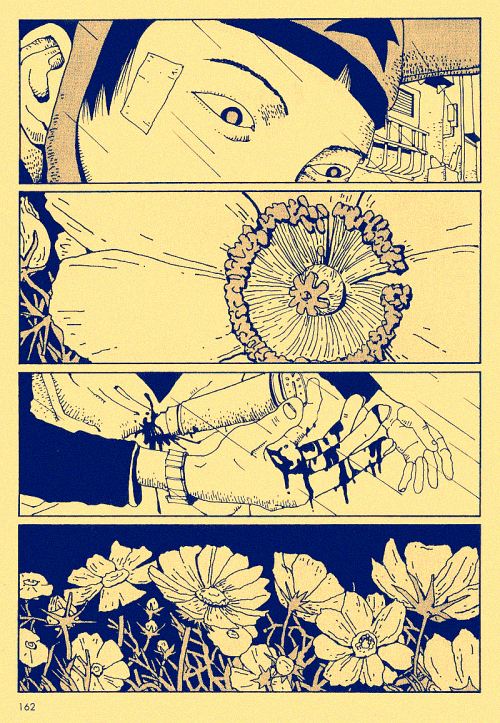
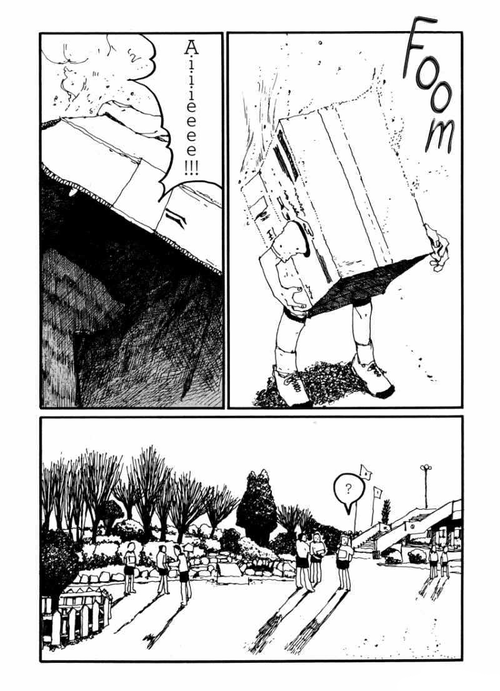
Yanakano_san rated it it was ok
Dirty hopelessness, absolute inanition, students with their clapping game of bloody happiness – young people who were too old and apathetic since the very, very first moment of life.
Matsumoto may call them “the heroes of my youth” – I call them “the lost generation”.
Because something (strangely sounds like “oh shit!”) happens, always did and always will, and let it happen – who cares anyway? Who? Is there any point? Has there ever been?
They know the right answer (which is “no, never”).
They are able to kill for nothing, to die for a far, ghostly goal and to live without feeling alive in the mess of blood, flesh and madness of Japan; their spring is blue, and their summer will come only to make them all finally fade.

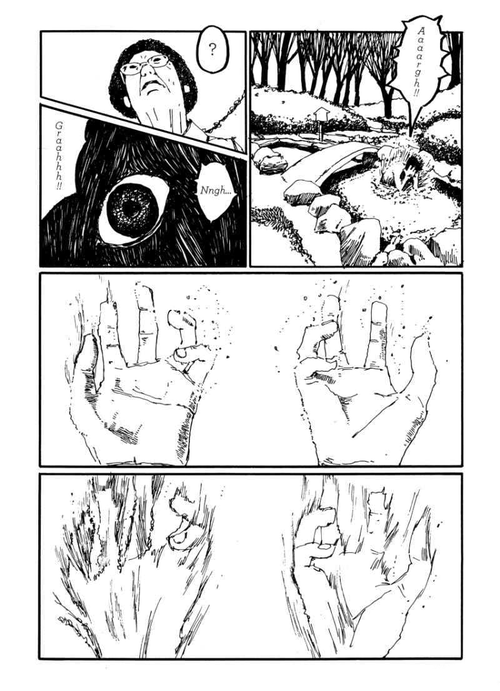
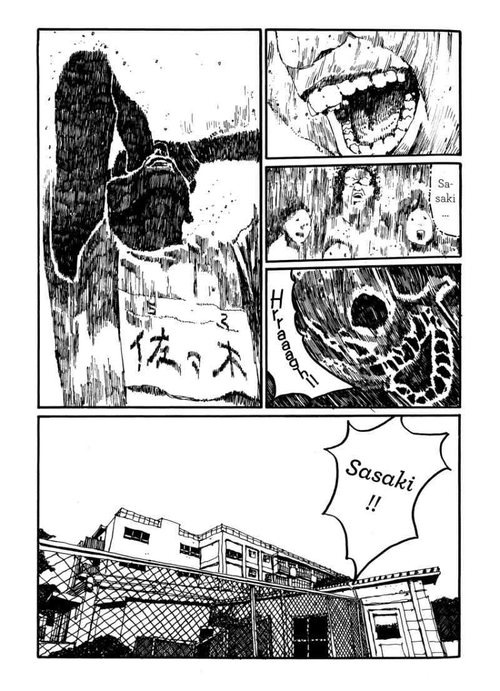
(D) The main action of the book takes place over five chapters: Spring, Summer, Fall, Winter… and Spring. This is a cycle, though, not a schematic. If anything, GoGo Monster is reminiscent in tone (not style) of John Porcellino at his sensation-of-moments airiest, with seemingly half the pages in the book devoted specifically to evocation: word balloons floating idle chatter in the air, familiar characters’ faces gazing out, words repeating, images repeating, airplanes, rabbits, scribbles on a desk, not so far from the scribbles that are the children.

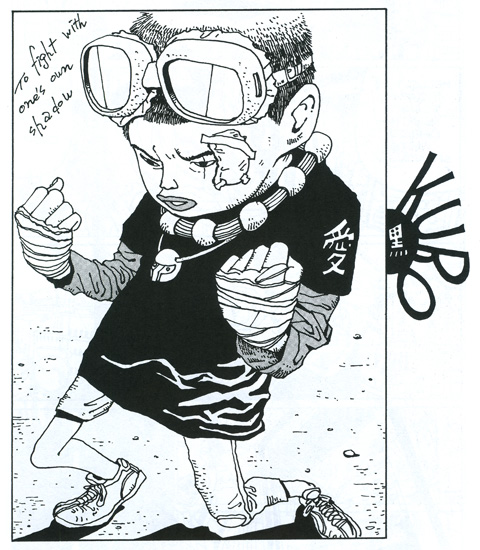
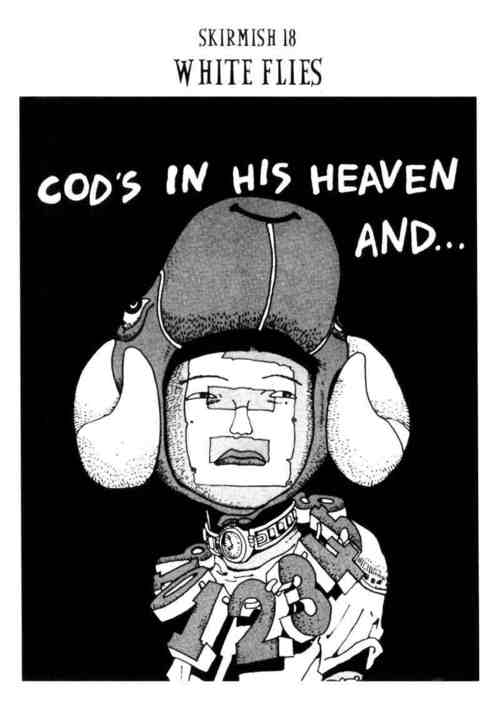
5.0 out of 5 stars A uniquely brilliant manga.
By hi on 11 May 2010
Format: Paperback
Taiyo Matsumoto is not your average manga artist. Blue Spring, one of his earlier works, is a collection of short stories about adolescents in the transition between youth and manhood. They refuse to conform to what they see as a bleak present and an even bleaker future, as if confused and angered by it all, with Matsumoto showing their detachment through their daily escapades with the yakuza, society and themselves. It is unflinching in depicting the harshness of their realities with the stories ranging from a deadly rooftop game to a group of young baseball players reminiscing over a game of mahjong with ‘Revolver’ being my favourite and most complete of the stories.
It struck a chord with me because the anxieties they felt were very human while their brash actions and sometimes extreme violence depicted how we would act if we rebelled against our inhibitions. The characters all had recognisable qualities in them but at times felt quite disturbing, especially in ‘What do you want do be when you grow up, Yukio?’ The content is quite explicit throughout underpinning the nihilistic lives that these youths lead with the raw art style reflecting this.
I didn’t expect to like Blue Spring as much as I did but definitely feel lucky to have found it. It doesn’t try to act as a social commentary, it simply acts as a depiction, with the author himself putting it best when describing youth as a blue time:
“Blue – that indistinct blue that paints the town moments before the sun rises. Winter is coming.”
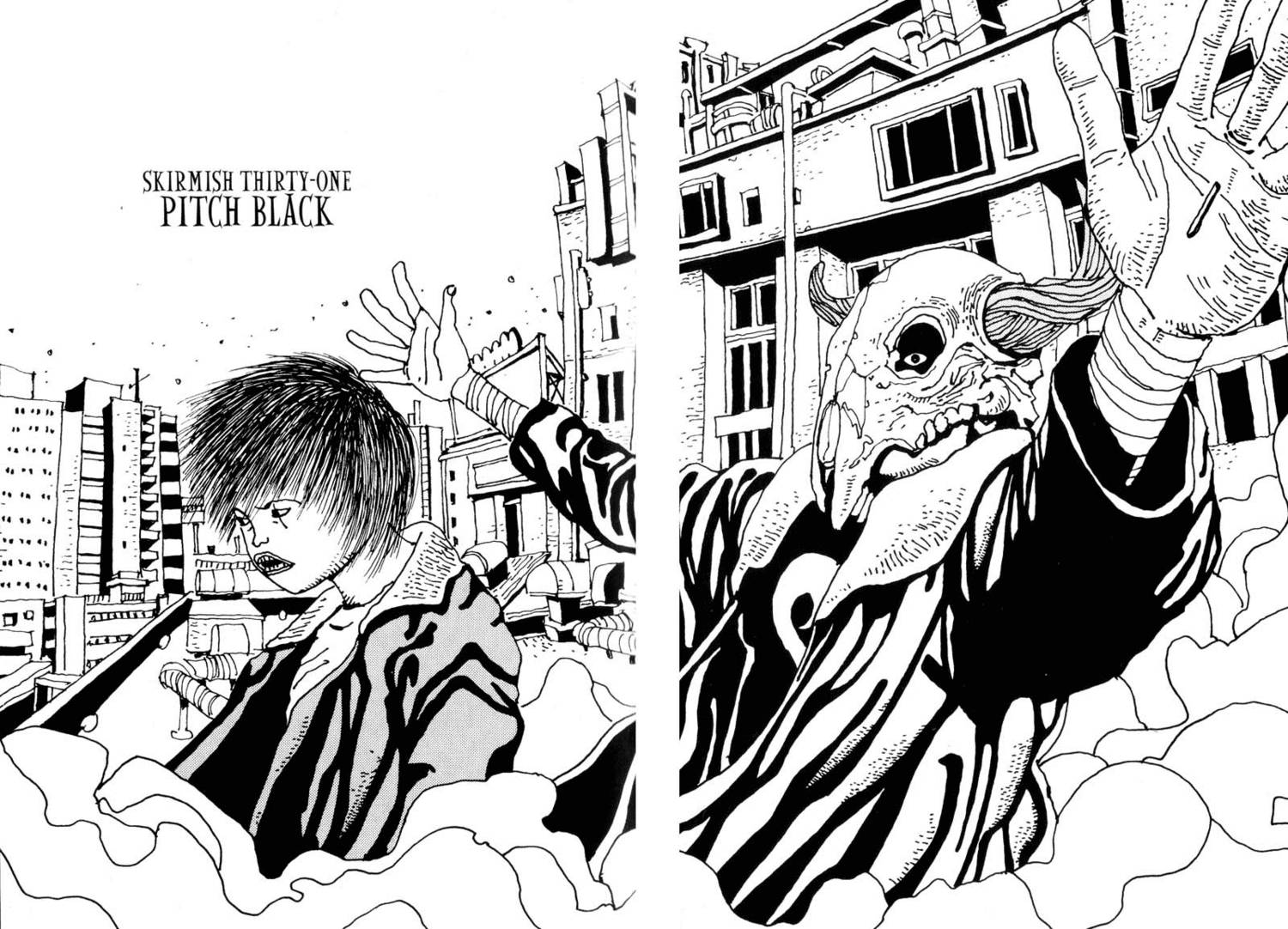
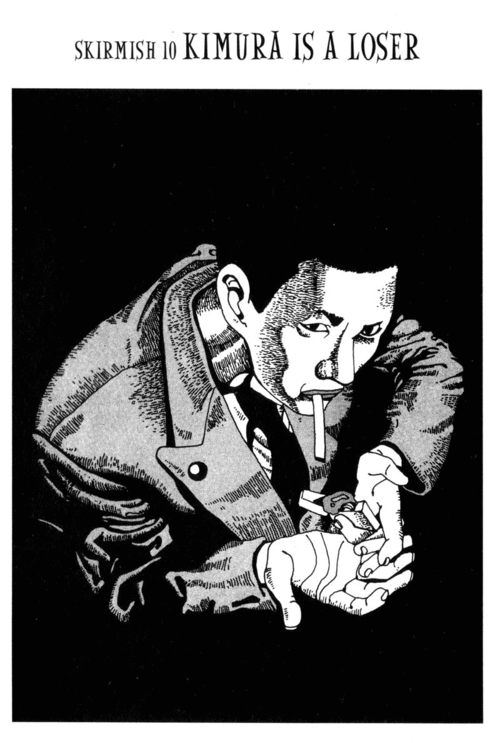
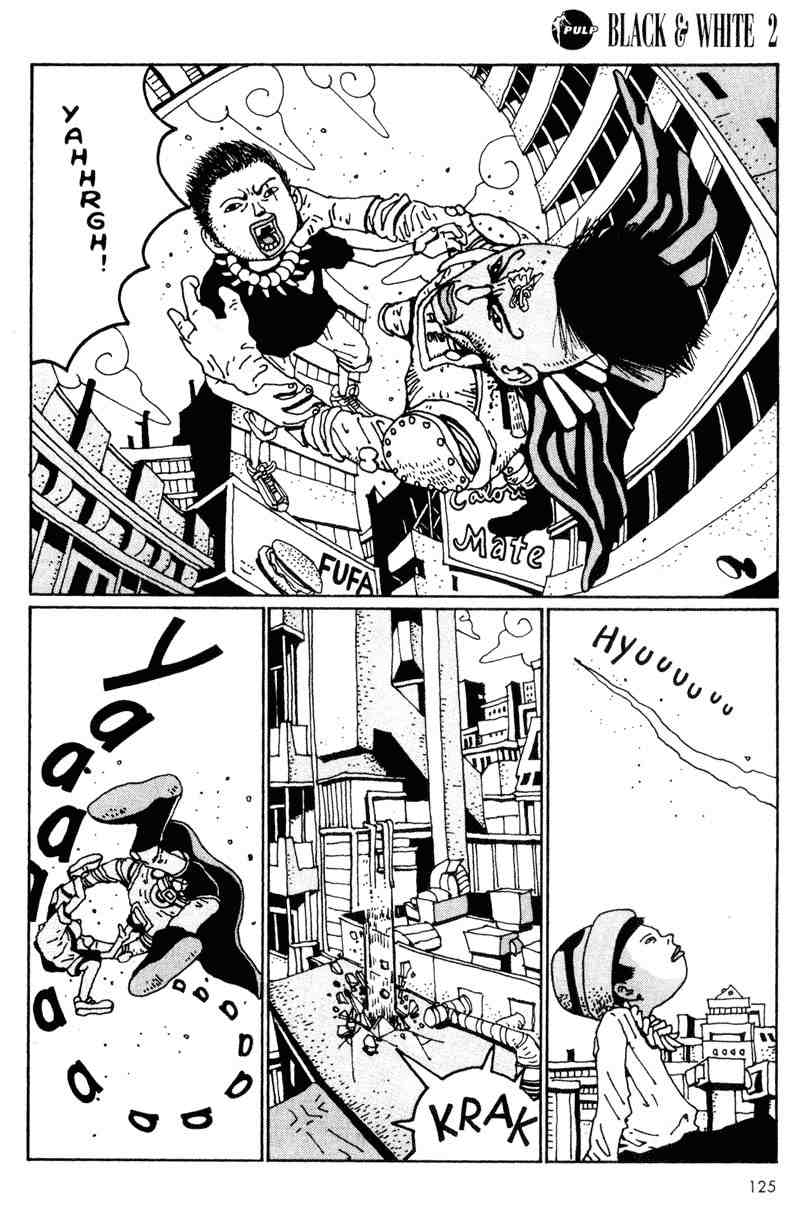
(E) Dotting this mental-temporal landscape are startling scenes and images, ranging from a multi-page depiction of a boy swimming in front of an adult — every page-topping wide panel set outside the pool exactly the same while below are jagged, tense variations of working through water with a cramp — to one of the indelible character designs of 2009(/2000) in the form of the story’s semi-antagonist I.Q., an older boy wearing a silly assortment of boxes over his head, always with a single hole cut out to reveal a spectacularly eerie photorealistic cross-hatched eye, always the most detailed bit of anatomy on any given page. Cross-hatching serves as the looming presence of adulthood throughout the book, finally erupting in a classic I-am-a-master-cartoonist-and-I-can-do-ANYTHING-I-WANT visual blowout climax in which all panels become filled with infinitesimally minute cross-hatches and stippling so that the reader is forced to stare deeply into every panel, slowly navigating as if literally in a dark room, just barely making out faces or legs or terrible animal shapes, and it’s actually scary.
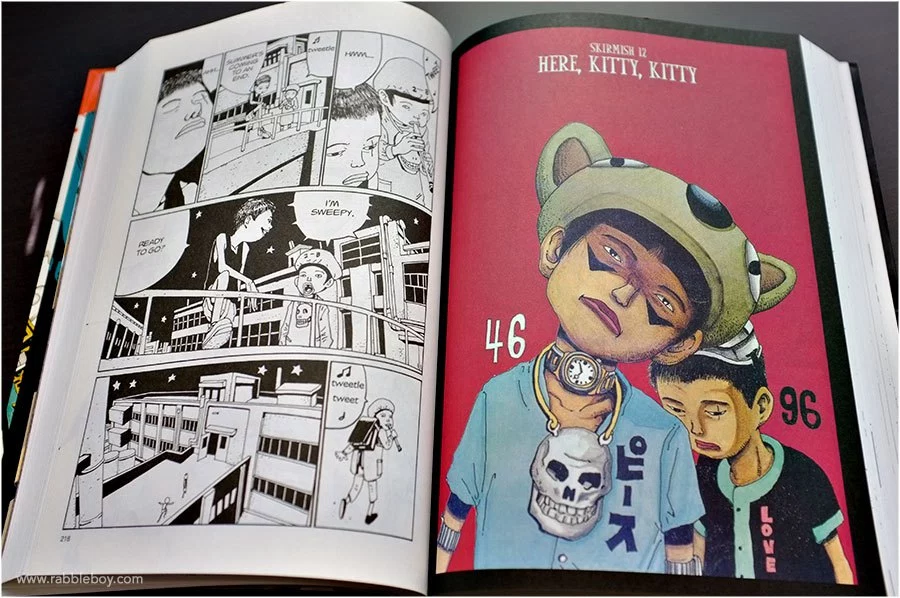
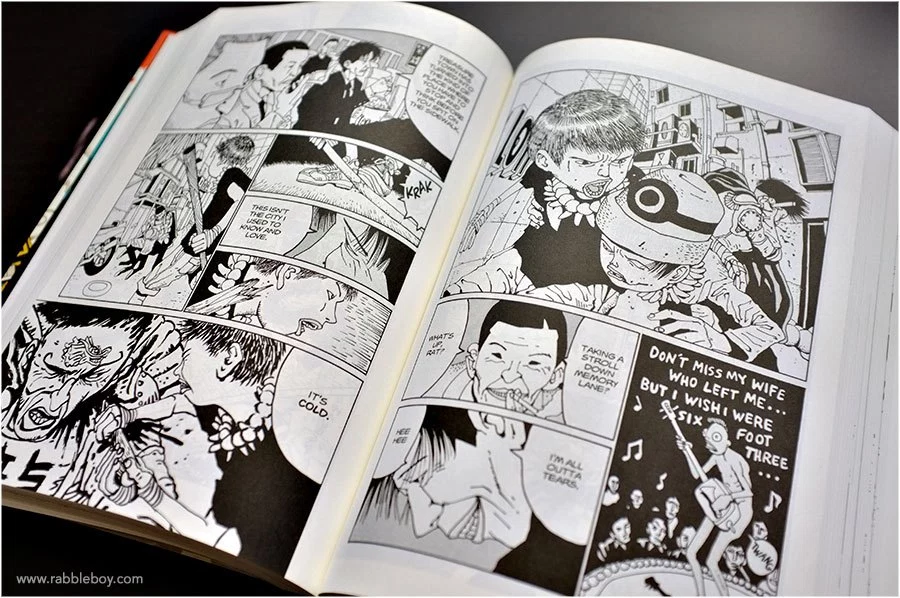
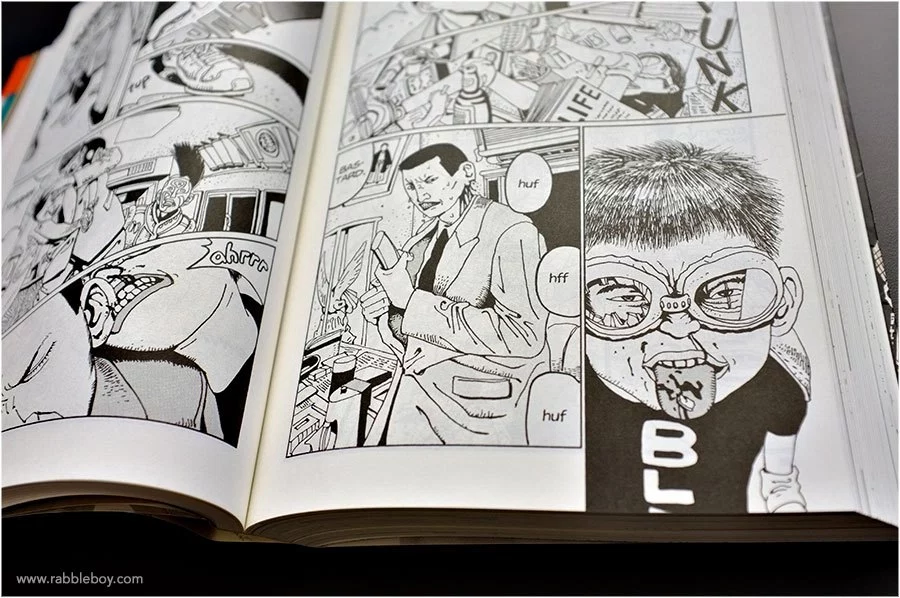
By L. Martin on August 3, 2015
Format: Hardcover Verified Purchase
This is a very strange manga. It is BEAUTIFULLY set up (pretty covers and slipcase, unusually high quality paper) which suggests to me that someone thought it was somthing extraordinarily fine. And yes it a fine manga—of a particular type. It is a story of an boy who is an outcast at school and lives in his imagination instead. This is a deeply meaningful subject for me because I was such a boy, and the first half or more of the book does a great job of showing how that feels, and what a great thing it is for a boy like that when he makes a friend. However, not much beyond that ever happens! No matter how symapthetic one is to the MC, I think any reader would like some events, developments, changes etc., and particularly a nice ending. I was waiting for some of any of those things, perhaps building interestingly upon the boy’s being able to further develop his new friendship with a second boy in the school, this one also being a semi-outcast like him, but instead all I got was an incomprehensible ending. I was disappointed.
The first half or two thirds of this manga tells such a moving story of the child outcast life that I can recommend it for that. Be prepared to deal with a mysterious ending, and perhaps you’ll love it as others here have.
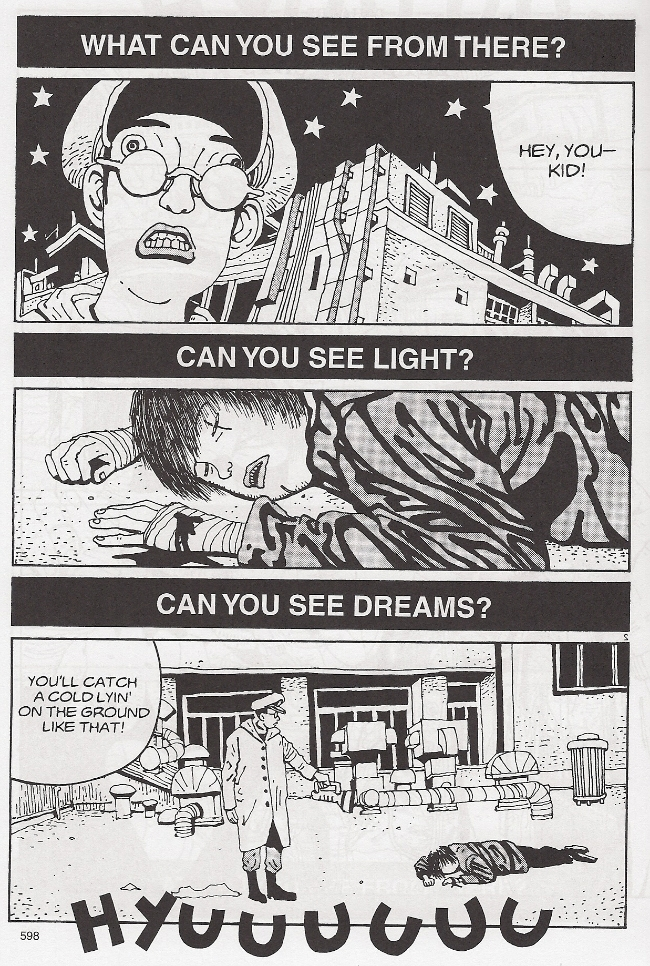

(F) All of this seems absolutely effortless, from the most worked-over panels to the (far more plentiful) pages of perfect, energetic doodling. I have no problem believing that Matsumoto may not have known what would be two pages ahead of him at any given time, though I doubt that’s true, it’s too complete a work. The book is best read in one sitting; it’s a breeze of a comic, sincerely refreshing. So great is its artist’s expressive power that even the book’s chilly, ill-fitting English typeface seems outright alien, as if drawing attention to the futility of translation. Aesthetes may still object, and they wouldn’t be wrong.

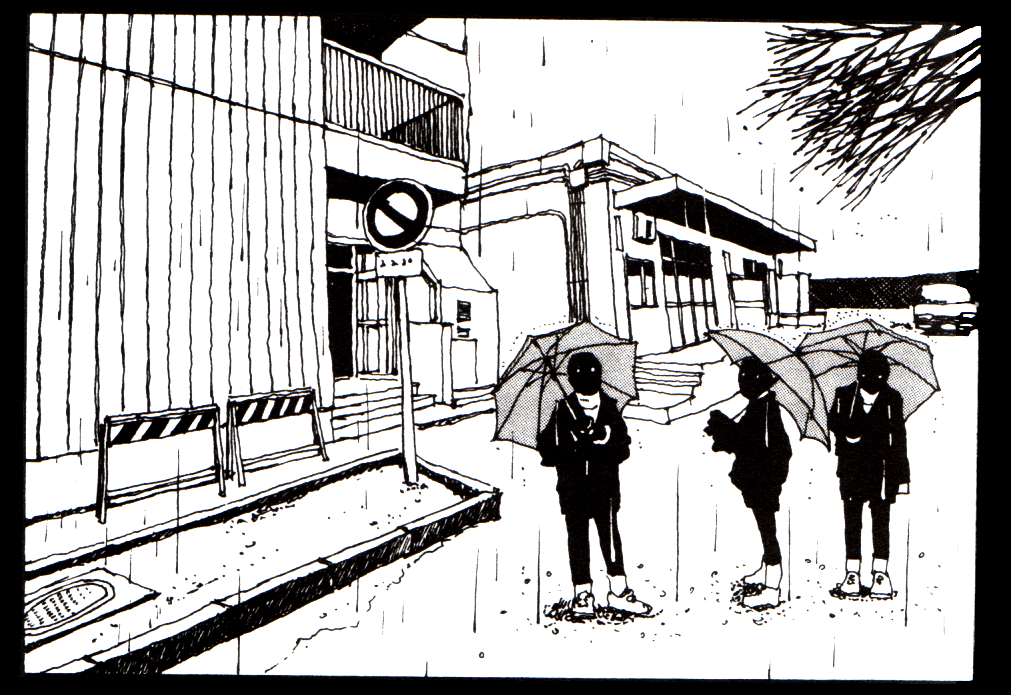
__________________
Writing
https://letsfallasleep.wordpress.com/2008/10/29/taiyo-matsumoto-and-michael-arias-influences/
http://marvelous-coma.blogspot.co.uk/2009/12/no5-vol2.html
http://www.cartoonstudies.org/schulz/blog/matsumoto-taiyo-a-comic-essay/
http://sites.gsu.edu/awalsh6/portfolio/critical-reflective-statement/
Podcast with great links below
http://www.factualopinion.com/the_factual_opinion/2013/06/taiyo-matsumoto-and-his-comics.html
All numbered and lettered points pertaining to Gogo Monster are written by Joe McCulloch and can be found in their original form by scrolling down at this link –
http://joglikescomics.blogspot.co.uk/2010/01/most-equivocal.html





*
P.s. Hey. ** Ferdinand, Hi, F. I am very not fond of that book cover, you are right. But cool that you got the book and especially ‘Discontents’. ‘The Swimming Pool Library’ is not my thing at all, but people who like that kind of thing do really like it. So enjoy. ** Dominick, D!!! Ah, excellent that your birthday felt like one. Right, of course, tattoo parlors are closed. Here too, I’m sure, since even the nail salon right outside my building’s front door is shut. Exactly, about one’s clone. Ultimately, it seems like it would mostly be traumatic. I’d love to be a fly on the wall of that self-help group, or, I guess, the ghost of a fly. Love turning every kindergarten into a guro art class, G. ** Misanthrope, I grew up in a mansion, as you probably know. It’s still there, I think. The best thing about growing up there was being absolutely sure there must be secret passages and hidden rooms and things and spending years scouring the place trying to find them, which I never did. Thanks for sympathies. I won’t belabor it, but, yeah, it is suckage central. ** David Ehrenstein, I think ‘Ma Rainey’s Black Bottom’ is on my favorite free/illegal movie site, so I’ll make sure to watch it. ** john christopher, It’s true, right? I’d be the world’s worst writer if that wasn’t true. I can pretty much guarantee you that any post you would end up finding it interesting to make I would love to have. So go nuts, if you do. Yum, Fugazi. I think my day needs that soundtrack, come to think of it. Not to mention chocolate. I did know that about Raf Simons, although I had completely forgotten about it. There was a video or something of that runway show. Yeah, that was a total surprise and very cool. Bye right back atcha. ** Steve Erickson, I liked that latest song. I often forget to mention when I like your songs in my spaceage. Good, apartment cleansing progress, good. The NFT thing is a super weird phenomenon. It seems bonkers to me. Collectors throwing money down a blatant toilet. It makes the millions that people are paying for KAWS seem almost understandable. Curious how long the frenzy will last. Not long, I don’t think. It’s a sign of something totally bizarre. Thanks re: the short cut, and, yeah, my right arm for one. ** Damien Ark, Hi, Damien. My pleasure, naturally. I’m doing fine. I hope you are too, sir. ** Brian, Hi, Brian! Abandoned and/or demolished things do have this kind of amazing charisma. I’m a sucker for it, obviously. Abandoned or demolished theme parks most of all, no surprise. Based on your very finely written and smart comments, I don’t think you need to worry about your non-fiction writing abilities. That seems like a pretty educated guess. ‘Literary weird’ seems flexible, and, at the same time, hemmed-in in a good way. Excited to see what you pick and what you say. Congrats on the A! And on the successful debate/discussion leading. Not a bad day, man. I mostly deleted files. And I finished and sent off my first ‘I Wished’-related interview. And I talked with the film producers, and everything seems to be on course. So, my day wasn’t too, too bad. What day is today? Thursday. Already? Weird. I hope it showers you with something pleasant at the very least like confetti, or, wait, gold doubloons. ** Kevin Kelly, Hi, Kevin. Nice to meet you, and thanks for coming in. Ah, thank you too for the correction. I’ll go fix that mistake as soon as I launch today’s post. Take care. ** Okay. Today’s post is another oldie guest-hosted by another long lost (seemingly) d.l. of this blog: Jamie McMorrow, a writer and musician and, as of last time I saw him here, a member of the current incarnation of the great Scottish band, The Pastels. Enjoy his foray into some interesting work, yes? See you tomorrow.




 Now available in North America
Now available in North America 
Hey Dennis. Sucks about the blog deleting. Thanks for taking the time to do it rather than scraping the whole thing.
I read Perfume over the last couple days and really liked it. I thought the obsession and desire was captivating. Also the short, little chapters and bouncy writing moved the book along so quickly that it never felt weighed down by description. Have you read it? Did you enjoy it? I found it to be much more enjoyable than the movie, which I remember liking when I saw it years ago.
Take care, Ian
Ps- thank you to Jamie mcmorrow for this great post. I will be creeping through it as the day goes by.
I shared today’s post with a childhood friend who is a illustrator, the author of this post is it the same Jamie who was in that indie band I remember you guys used to correspond here some time ago, how is he..
Enjoying reading poems (idols) i seldom do and to me poems seem like things transmitted from another dimension in full form and these transmissions sometimes turn quiet for a year or more.
Did u also have snow?
Hi!!
Ah, I remember this post. I loved it then, and I love it now. Thank you for reviving it!
Haha, yes. I guess seeing ourselves walking around would mostly be that: traumatic. So… maybe my love shouldn’t be your own clone but someone else’s you’d actually enjoy looking at all day long?
I didn’t see this love coming, haha. I’m all for it! Love waking up in a Poppy Z. Brite novel, not knowing whether he’s pretty enough to be in serious danger, Od.
Oh indeed i see now at the end of your P.S its indeed that Jamie, I knew he was in 1990’s and also The yummy fur but wow he’sin the current incarnation of The pastels, neat.
Lastly since im on poetry I will obsorb the recent Amy Gerstler. Liked the reading of her poem I sampled. The scattered sea. Cheers
Dennis, Cindy put up some pics on FB of y’all’s old home a couple months ago and I thought it was beautiful. And I’d be lying if I didn’t think of secret passages and all that. That’s one of the appeals of mansions to me. I expect that shit to be there! Even having lived in this little duplex most of my life, I have dreams all the time that there are secret passages.
There’s a scene in that second Batman movie where the Joker shows up at that party and Bruce Wayne takes off and goes through this hidden door to get gussied up as Batman. That might be my favorite scene, hahaha.
It might be surprising or not, but I think of secret/hidden passages a lot. I was looking at houses in the area the other day for shits and giggles and I was actually looking for those things and like where I could put some in these houses if I were to buy one.
Soooo….my mom’s getting this new scan Friday. She went to pick up the script for it from her doc yesterday and now they tell her they did find something in the bladder area on the first scan and that’s why they want to do this one. We’re all like, WTF, nice telling us now. Sheesh.
Oddly beautiful illustrated abjection.
Today is the birthday of my favorite communist Yip Harburg. Among his songs: Over the Rainbow and Brother Can You Spare a Dime
I’m surprised that there is not a major exhibition of Japanese Manga art in the U.S. I would think MoMA or some huge institution would be into that.
Oh wow, all this manga that looks so lush, a lance straight to the swollen boil of my pleasure centres! Have put TM on my list of Japanese (graphic) novels I want to hunt down. Sending my thanks to Mr McMorrow wherever they may be and you Dennis for restoring. I’ve just finished the second volume of a yaoi manga that was loaned me by a friend, called Yatamomo (which is a pun on the two protagonists’ names with a phrase that means ‘ to have fucked the peach’ hahah). My friend warned me that it was just smut, and I must concede that the plot is mostly a highly contrived (but kinda charming) melodrama about “fucked-up” teens cruising for sex, yet the way the architecture of panels, and the superimposition of text/thought, and the art style lays out the subjectivity of the characters, as well as the physicality of the sex/action etc has been on my mind lots, it’s super engaging well beyond what I was expecting. I know you’re interested in guro, Dennis, but I was wondering if manga/graphic novels as a form have also influenced your writing at all? Or do you have particular favourites?
Otherwise, sending you a long draft of patience with the continuing deletion chore. Without wanting to sound glib, I’m very glad of your blog every morning and grateful for all your efforts to continue sharing it with us!
Hey Dennis!
Was a lovely surprise to see this re-presented this morning. Thanks. I’m still around. I fell out of the habit of commenting then felt kind of shy, like I’d been away too long. Silly really. I still check out the blog every single day, of course, and it’s still my favourite place on the internet.
How are you? I’ve been reading about your horrible situation with deleting all the duplicated images on the blog and it sounds really arduous. Your dedication to this blog is amazing and I’m eternally thankful for it.
Hannah and I are living in Brussels and have a baby, maybe more of a toddler now, Ari. Crazy changes.
Manually deleting duplicated images and global pandemic aside, I hope things are good with you.
Much love,
Jamie
Thanks for your praise on the song. My next one will feature more ice cube samples.
The Jeff Koons bubble hasn’t burst yet, so perhaps Biebz’ KAWS collection will still be worth tens of millions in 2040. I understand NFTs as an extension of the concept of paying $9.99 for a music MP3 that has no physical form, but the banal things that people are paying millions for and the way the market escalated just reek of a fad that will end soon. I mean, Ja Rule is selling an NFT of a photo of the cheese sandwiches given out at Fyre Fest. Great scam on his part.
I wish you didn’t have to manually delete all those files. Are you gonna hit the minimum mark to satisfy WordPress soon?
Lagtst FaBlog: The Second Amendment Solution Strikes Again!
I loved Gogo Monster. Don’t think I saw this post the first time around. Will definitely check out more Matsumoto. Just look at those gorgeous panels.
I’m inadvertently having a “depressed 70s/80s Britain” week, reading Jon Savage’s excellent oral history of Joy Division, and the Joel Lane collection Where Furnaces Burn.
Bill